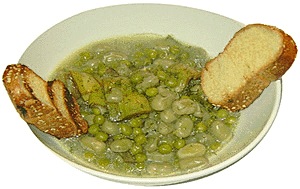...Best of Sicily presents... Best of Sicily Magazine. ... Dedicated to Sicilian art, culture, history, people, places and all things Sicilian. |
by Roberta Gangi | ||
Magazine Index Best of Sicily Arts & Culture Fashion Food & Wine History & Society About Us Travel Faqs Contact Map of Sicily |
Simple though frittella may be, it's full of nutrients and healthy fiber. What should be mentioned is that the ingredients must be fresh. Bottled artichoke hearts, dried broad beans or canned peas will not do. In fact, it's the synergism of the fresh, green ingredients (even the olive oil might be greenish in hue) that makes frittella so delicious. Instead, dried fava beans, with their brownish color, are used to make macco (maccu) a dense soup popular in winter. The name itself is potentially confusing, as a number of Italian foods are called "frittella" and "fritella" (with one "L"); these include various kinds of fried cakes. In preparing fritedda, purists prefer thorny Sicilian artichokes for their strong flavor. There's no doubt that these artichokes, harvested from late November into April, have a particularly "wild" taste. It should be remembered that only real fava beans (Vicia Faba Linnaeus) are recommended for this recipe. This species has been cultivated in the Mediterranean region since the earliest historical times. There exists a somewhat similar Greek dish, served cold, with green olives substituted for the peas, and the artichokes marinated rather than cooked. Frittella is the epitome of the Mediterranean Diet, and while some vegetarians oppose the use of cooked vegetables it is difficult to imagine eating freshly-harvested artichokes raw! Fritella has as good a claim to antiquity as any dish, and evidence suggests that it was already known in Greek Sicily. Here's a simple recipe: Boil the freshly-sliced hearts and tender leaves of four medium-size artichokes for about five minutes or until partially tender but not yet quite soft enough to eat. Add two cups of large green fava beans (outside Italy these are sometimes sold as "green broad beans") and about a half-cup of fresh peas. Regardless of the measure you use, the proportions should be approximately two parts beans, one part artichokes and one-half part peas. Boil the ingredients for about seven minutes after adding the beans and peas, adding water if necessary. The artichoke pieces should be soft and the fava beans should be tender enough that the skin comes off easily with a fork, though this skin may be eaten. Drain the remaining liquid. Mix in about six large tablespoons of extra virgin olive oil, more if desired. Salt and pepper to taste. Fritedda is usually served warm but serving it chilled or at room temperature might occasionally be appropriate. A few people are allergic to fava beans (the rare condition called favism results from hemolytic anemia or G6PD enzyme deficiency), but otherwise almost anybody else who enjoys green vegetables will probably like frittella. About the Author: Roberta Gangi has written numerous articles and one book dealing with Italian cultural and culinary history, and a number of food and wine articles for Best of Sicily Magazine. | |
Top of Page |
 Frittella, or fritedda, is a dish traditionally served
in Sicily during mid-spring, when the key ingredients are harvested. It's
the kind of recipe that most people either love or hate, based entirely
on fresh but cooked green vegetables. The principal ingredients are green
Frittella, or fritedda, is a dish traditionally served
in Sicily during mid-spring, when the key ingredients are harvested. It's
the kind of recipe that most people either love or hate, based entirely
on fresh but cooked green vegetables. The principal ingredients are green